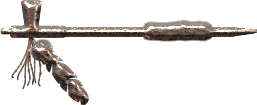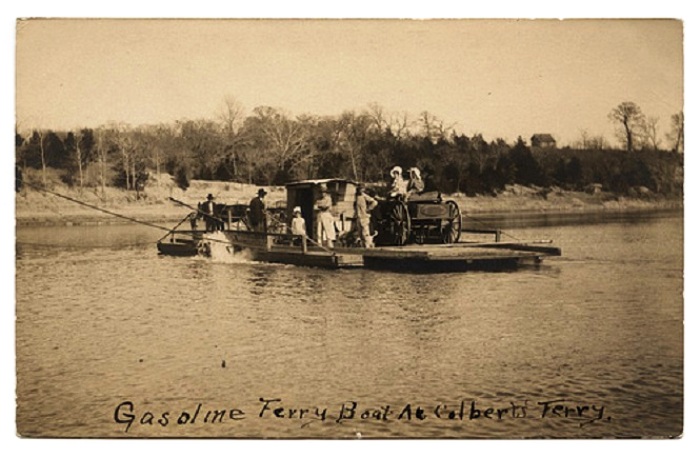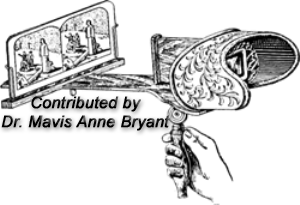 Benjamin
Franklin Colbert (1826 - 1893) was the son of a Chickasaw chief and a
French mother, Martin Colbert and Sallie Allen. He and his
Chickasaw wife had a son, Holmes Colbert.
In 1853, the Tribal Commission granted Frank permission to establish a ferry on the Red River.
 . . . Colbert's Ferry. . . . . . Colbert's Ferry. . .  Colbert's Ferry was established about 1853 approximately five miles north of Denison. Operated by Benjamin Franklin "Frank" Colbert (1826 - 1893). Across it came thousands of immigrants into Texas in the 1850s. The Stages of the Southern Overland Line which provided mail and passenger service between St. Louis and San Francisco, crossing 1858-186? and abandoned in 1931 when a high (free) bridge spanned the Red River. In about 1853 Ben Colbert opened up his ferry downstream to cash in on the California gold rush. After the Civil war, business at the ferry boomed, as thousands made their way west on the Texas Road. Colbert's location became the most popular crossing from Oklahoma to Texas. It was not unusual for Colbert to carry two hundred wagons across the river in a day. Frank became one of the richest and most prominent members of the Chickasaw nation, owning large herds of cattle, a steam-driven sawmill, a gristmill, a cotton gin, and hundreds of acres of land on both sides of the river. Source : Bryant, Mavis Anne, Lives in Photography : Denison, Texas, 1872 - 1999, c2012; pgs. 91-93 The toll was $1 for a two-horse wagon, $1.25 for four-horse wagons and $1.50 for six horse wagons; 25 cents for man and horse, and 10 cents a head for loose cattle or horses. There was very heavy immigration all through 1871 and18'72 and we would put across from 25 to 200 wagons per day besides loose stock; it was also the main road for freight between Fort Gibson and Sherman, Texas. The freight wagons were from four to six mule teams with trail wagons and ox wagons from four to five yoke of steers to each wagon besides trail wagons. Their load would weigh 30 or 35 hundred weight on front wagons and 20 to 25 hundred weight on the trail wagon. There would be from 20 to 30 teams to an outfit under a wagon master. The boat ran on a cable across the river and made a round trip in 25 to 40 minutes if we had no trouble and a good current. But many times we had trouble with the teams coming on the boat and sometimes with the drivers.  The
DeGolyer Library labels this card, with its yellow mount : "By 1872,
Colbert's Ferry was the principal Red River crossing from the Indian
Territory into Texas. This view shows one of the expedition
wagons aboard the ferry as workers begin the river crossing.
[Imprint] Photographed and published by Martin & Troutman of Paris, Illinois. Stereoscopic Views of Texas and Indian Territory. 12. Colbert's Ferry Red River, Lookin up." Source : Bryant, Mavis Anne, Lives in Photography : Denison, Texas, 1872 - 1999, c2012; pg94  Waterways Susan Hawkins © 2024 If you find any of Grayson County TXGenWeb links inoperable, please send me a message. |